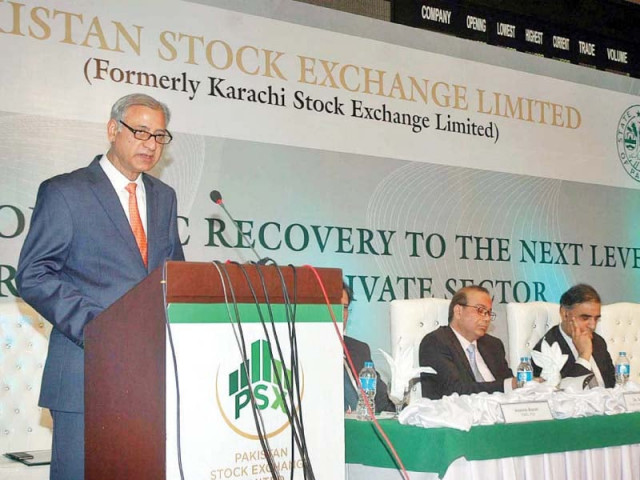Surplus liquidity: Wathra pushes for investment in real economic activities
It will help achieve robust growth as corporates have healthy surplus of funds

Referring to a higher GDP growth in recent years, adequate foreign exchange buffers and low inflation, the central bank governor said “no major risks are in sight”. PHOTO: APP
State Bank of Pakistan (SBP) Governor Ashraf Wathra urged private businesses on Monday to accelerate domestic investment to achieve robust economic growth.
Speaking at the Pakistan Stock Exchange (PSX), Wathra said it is the opportune time to invest in new projects given the historically low interest rates, marked improvement in security conditions and energy supplies and the launch of China-Pakistan Economic Corridor (CPEC)-related initiatives.
“The corporate sector is fairly liquid and possesses a healthy surplus of investable funds,” he told a hall full of private-sector professionals from different sectors of the economy.
Referring to a higher GDP growth rate in recent years, adequate foreign exchange buffers and low inflation, he said “no major risks are in sight” that would undermine efforts to achieve high growth, generate more jobs and move forward on the development frontier.
In his presentation titled “Taking economic recovery to the next level: role of the private sector,” SBP Chief Economic Adviser Dr Saeed Ahmed said the private sector must lead Pakistan’s economic recovery.
A review of the non-financial corporate sector data, conducted by the SBP, reveals a marked improvement in the liquidity condition coupled with gradual deleveraging since 2009.
According to Ahmed, the most conservative estimate of net surplus with the corporate sector is Rs446 billion - calculated as current assets net of current liabilities, without additional borrowing.
“It is noted that some entities have parked their liquidity in treasury bills and Pakistan Investment Bonds (PIBs). This is disturbing, as the corporate sector is looking to benefit from investing in risk-free government securities instead of investing in real economic activities,” the SBP chief economic adviser added.
The presentation also provided some estimates of the potential investable resources of the non-financial corporate sector that, upon deployment, can increase the investment significantly and contribute to economic growth as well as job creation.
The total investable resource - defined by Ahmed as twice the size of equity (based on the assumption of a debt-to-equity ratio of two) with short-term investments, cash and near cash and excluding the total liabilities - turns out to be over Rs2.6 trillion.
More than half of this potential lies in the energy sector alone, he said, adding that other major sectors include cement, textile and auto.
According to another definition of computing the potential investable resources, which replaces total liabilities with total borrowings, the potential reaches over Rs3.7 trillion while the major sectors remain the same, Ahmed said.
The cost of borrowing for the private sector has come down to only 7.2%, which is the lowest since 2005, he said. Similarly, the SBP has also reduced interest rates on the long-term financing facility, which are in the range of 3% and 4.5% with the end-user rate being 6%, he said.
Published in The Express Tribune, March 15th, 2016.
Like Business on Facebook, follow @TribuneBiz on Twitter to stay informed and join in the conversation.


















COMMENTS
Comments are moderated and generally will be posted if they are on-topic and not abusive.
For more information, please see our Comments FAQ